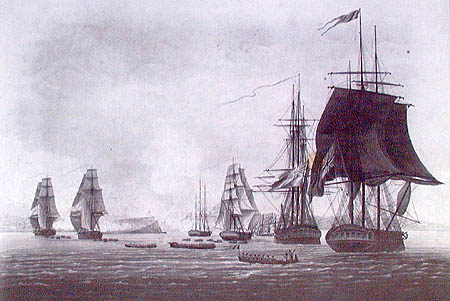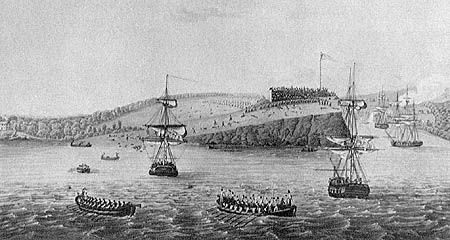Taken from the book "In the wake of the Eighteen-Twelvers" by C.H.J. Snider

Queenston Heights was over. Every-body said the Yanks had got enough then to last them till the peace was declared. You know, the first year of the war, it was only Brock and a few others that took the thing seriously. Most everybody else looked for a wind-up every month; and after the old brig Moira came into Kingston loaded with prisoners from Niagara, people went about as though the war was over. Commodore Earle went up the lake in the Prince Regent, and the Royal George and the Moira followed. This was afore Sir James Lucas Yeo came up from salt water and took over the squadron. November set in wild, and round the docks they began to wonder whether the Commodore‘d get back with the fleet or have to winter in York. A fishboat came staggering from the False Ducks, thirty miles to the west’ard, the night of the eighth of November. The Royal George had been cut off by the American fleet, the fishermen said, and had to run into the bay of Quinte. Perhaps she’d dodged ‘em in the dark. The fishermen guessed right, for at daylight next morning our three-master came bowling down the North Channel, with her sails so full of shotholes they looked like the cook’s colander. On her track like water-spiders crept five Yankee schooners with long sweeps through their ports. The wind was light and their crews was breaking their backs at the big oars. After them lumbered the brig Oneida, the flagship of Commodore Isaac Chauncey that year. The George stood in and anchored under the batteries, and the schooners hove to off Snake Island shoal outside the harbour and waited for their flagship. Farmers came swarming in with all their worldly goods in wains an’ ox-carts. The Yanks had terrified ‘em all along the Quinte shore. They had landed at Ernestown. Their biggest schooner, the Hamilton, the one that drowned all hands next year off Niagara, she hung behind while the others chased the George. She caught a harmless little trading schooner at the Ernestown wharf, stripped her of her sails and gear, and set fire to her. Poor old Cap’n Conn, he stood there on the shore, wringing his. hands, while all he owned went up in smoke. War’s no picnic for the losers, believe me, boys. On in the afternoon the Yankee fleet off the Snake hoisted brand new battleflags at every masthead and closed in. The Oneida had a battery of sixteen twenty-four- pounders, guns as heavy as the George’s, and almost as many. She was backed by the gun-schooners Chauncey made famous—little water-waggons, each top-heavy with a long thirty-two-pounder amidships and smaller guns at the sides. They was no good in a seaway, but wicked at long range in smooth water. They lay just beyond reach of the George’s carronades and pelted her with round-shot till the blood ran from her scuppers. Four times soldiers from the fort was sent out to reinforce the spent gun-crews, and all the time the George’s shot was just making holes in the air and water. Some fetched the Oneida, for she had to close in, but the schooners went scot-free, all but one. This was the little Pert. Her gun burst at the third shot, and the George got in a few good ones at her before she hauled off; but in the end they had to slip the George’s cable and warp her in to the Garrison pier, where the Yanks could only get her by boarding. It looked as though they’d try that, for by this time they’d been reinforced by their schooner Governor Tompkins, which had spent the day running down a Kingston-bound Niagara vessel, the Mary Hall. But as the sun sank it began to breeze up hard from the sou’-west, right into the mouth of the harbour. If we could ‘a just winged one vessel then she’d ‘a been ours, for the wind would ‘a driven her right ashore once she was crippled. Chauncey was a wise old bird. He knew the Oneida sailed sideways like a crab, going to wind’ard, and some of the others wasn’t much better; so he hauled off while there was time, and thrashed up to the lee of Four-Mile Point, away across the harbour, and came to an’ anchor there. Special thanks to the Marine Museum of the Great Lakes in Kingston for use of this image . ATTACK ON FORT OSWEGO, MAY 6,1811 The following reproductions from paintings, show vessels from the Provincial Marine in Kingston Ontario attacking Fort Oswego on May 6,1811. The ship "Royal George" is one of the vessels depicted, though I'm not sure which.



Special thanks to the Marine Museum of the Great Lakes in Kingston for use of these images . |
|---|